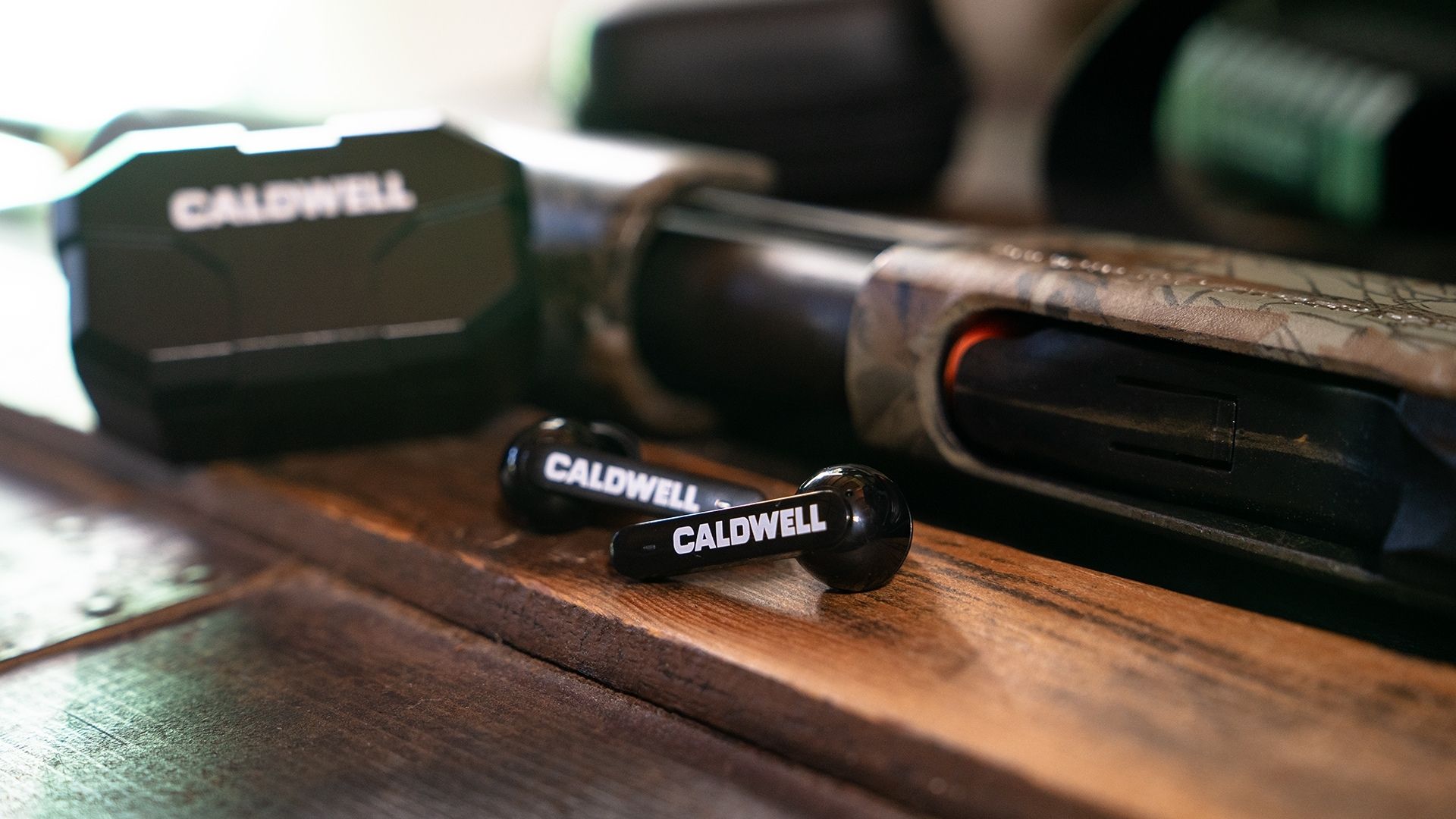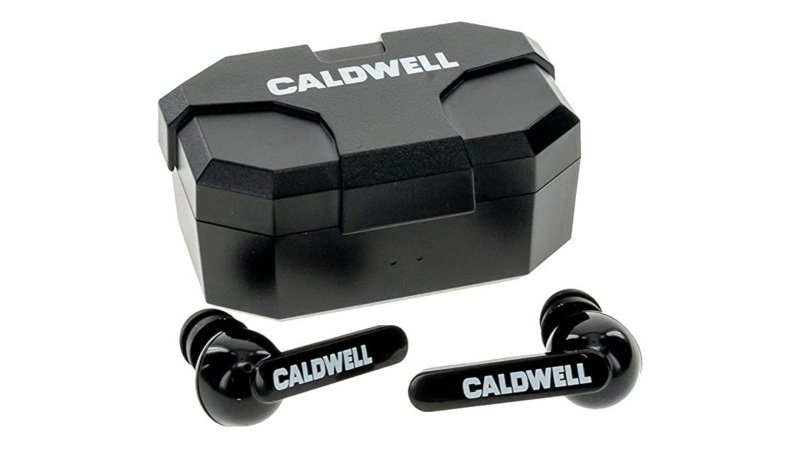

We may earn revenue from the products available on this page and participate in affiliate programs.
Technology is a fickle beast. It dazzles us with visions of the future, hangs around just long enough for us to spend money on it, and then vanishes into obscurity (shoutout to all the school districts that blew their budget on Laserdisc players). It’s frustrating, for sure, but somewhere in the middle is a sweet spot where value can be found.
Caldwell’s E-Max Shadows ear protection seems to have found the point where technology is attainable for a reasonable price but still relevant. At less than $100 on sale, these earbuds land closer in price to active electronic earmuffs (which can be found for as little as $20) than many in-ear alternatives. Features and comfort play a role in shooters’ purchasing decisions, too, but the E-Max Shadows are certainly attention-grabbing next to a pair of $200 Walker’s. Being competitively priced means that Caldwell’s ear protection doesn’t have to be quite as good as the competition––but is it?
I’m all for testing gear in real-world situations. If it’s crap, you deserve to be warned. If it’s good, I want you to know about it. If there’s a chance it can perform well and save you money, that item goes straight to the top of my to-do list. This brings us to a pair of Caldwell E-Max Shadows that arrived on my doorstep.
Caldwell E-Max Shadows
Unboxing
The E-Max Shadows might be a value proposition compared to some of the other earbuds I’ve shot with, but Caldwell’s presentation of them is far from low-budget. First off, the earbuds are very lightweight––only five grams each on my scale. That causes them to feel a little less robust than some of the competition, but not flimsy and very similar to the earbuds you probably use to listen to music already. Six types of rubber ear inserts are included; that’s more than I’ve seen any other ear pro manufacturer provide. There are three sizes of barrel-shaped inserts and three sizes of the twin-cup design you probably have on your issued ear pro.
The charging dock is standard earbud fare, with lightweight construction and a hinged lid. It’s nothing fancy, but plenty of shooters would rather not pay for an overdone case. It’s solid enough to chuck in my range bag, at least. An LED on each earbud glows red while charging, then turns green for three seconds when charging is complete. If the LED is dark, the earbuds are good to go.
Between the earbuds, charging case, rubber ear inserts, and the USB cable, there’s a lot to keep track of. Caldwell sells the E-Max Shadows with a rigid clamshell to hold everything, and I think that’s a considerate touch. This way, everything can fit in one case rather than leaving the accessories loose in my range bag while the earbuds sit safely in the charging dock.

How we tested the Caldwell E-Max Shadows
Before I made it to the firing line, I used the E-Max Shadows as normal Bluetooth earbuds. I’ve read a few customer reviews that described pairing problems, but I didn’t encounter anything like that. My E-Max Shadows paired with my phone right away and had no problem playing music, podcasts, or audio from Flannel Daddy videos played in the YouTube app. The sound quality was comparable to basic, non-shooting earbuds but with a fit that was better than what you’d get from the hard plastic most manufacturers use.
Next up was a trip to my local shooting range for a day of firing warning shots at clay pigeons. A 12-gauge shotgun paired with a 28-inch barrel is comparable to many rifles and handguns in terms of sound production, even if it doesn’t have the crack of a supersonic rifle round. Unsurprisingly, almost all gunshots are considered dangerous in terms of hearing damage. For comparison, I brought along disposable foam earplugs and my trusty pair of active noise-canceling earmuffs.
The E-Max Shadows is one of the more affordable electronic earbuds available to shooters, so my expectations were somewhat conservative. I honestly wasn’t ready for them to perform as well as they did.
Setup was nonexistent; I just took them out of the case, popped one in each ear, and was off to the races. There was no startup sequence, no pairing, and no toggling through modes to find the right one. The earbuds just came to life and started working on their own––it doesn’t get easier than that.
Once up and running, gunshots were managed well. They sounded true-to-life (rather than muffled, as is the case with some ear pro); just much quieter. Voices came through loud and clear. The audio quality itself was tinny compared to some of the alternatives, but that’s fine. I need my hearing protection to reduce harmful sounds, not dazzle me with thumping bass and full midrange. Volume was easy to adjust without gloves by swiping up or down on the outer stalk’s touch panel.

What we like about the Caldwell E-Max Shadows
So, what’s there to like about the E-Max Shadows? Quite a bit, as long as you know what you’re getting into.
Value is a relative term. That being said, most of us own several types of ear protection and traditional headphones. Shop the sales, and you can get the E-Max Shadows for less than $100 and use them in place of foam inserts or earmuff-style hearing protection at the range, then listen to music and make calls everywhere else. The more you use these, the more affordable they’ll seem. I’d argue that this combination of practicality and price is worth looking into.
Selective sound reduction is the whole point of active hearing protection. Picking up range commands and carrying on a conversation is easy with the E-Max Shadows. Volume is adjustable without affecting the level of protection against harmful sounds. Better yet, the user experience is incredibly easy. Some earbuds include so many settings and features that it takes several minutes to get them set up properly. I didn’t run into any of that with these earbuds. The sound reduction is adequate, but not exceptional. I’d be totally comfortable using these for any outdoor shooting; just be aware that they don’t offer enough protection for indoor ranges.
What we don’t like about the Caldwell E-Max Shadows
As with any value-based product, this hearing protection had to make certain sacrifices to remain affordable. Are these deal-breakers? No, but they’re worth mentioning.
I get why Caldwell chose this shape for the E-Max Shadows; it’s functional and used by many earbud manufacturers for a reason. The stalk provides a great place for a microphone and can be used for buttonless touch commands, but it also sticks out and is just begging to get caught on something. This might not be an issue at a shooting bench, but if you were to wear these during hunting or during more dynamic training, it wouldn’t surprise me if they got snagged on a branch and fell out. Have fun rummaging around in the leaves for tiny, black earbuds.
Material is another area where Caldwell could have done better, although I understand concessions have to be made to hit certain price points. The E-Max Shadows are built from the same type of hard, shiny plastic as the earbuds that probably came with your phone. This does the trick, but it scratches easily and I suspect it won’t hold up to being dropped on the ground and rattled around in your range bag as well as some of the higher-end alternatives that use softer materials. I recommend using the carrying case every time you put these away.
Verdict
There are so many quality forms of hearing protection out there that the question is less about which is best, and more about which is right for you. E-Max Shadows earbuds are for shooters who want to get a compact earbud without blowing the budget. They’re incredibly light and compact, work well at the range, and can be paired with another device via Bluetooth (easily, I might add).
Audio quality isn’t the best, so they wouldn’t be my go-to for music. This also isn’t the most sophisticated range gear you can get. If you want something solid for a competitive price, though, snatch a pair of these up and don’t look back.
Saved rounds
One morning, the attendant at my gym got unexpectedly excited when he noticed my iPod. “Woah,” he exclaimed with an outstretched finger pointing at my iPod. “That’s so old-school! And you got the headphones with the strings! What’s the deal, man? Are you just into retro stuff?”
The gym staff had their fun that day, but now I have headphones without the strings and they even protect my hearing. Who’s laughing now, Colton?
FAQs about the Caldwell E-Max Shadows
More questions? Here’s Task & Purpose’s additional brief.
Q. How much do the Caldwell E-Max Shadows cost?
A. The E-Max Shadows have an MSRP of $149.99, but I found them on sale on Amazon for $84.30 at the time of writing.
Q. How effective are the E-Max Shadows at reducing sound?
A. The E-Max Shadows carry a noise reduction rating of 23 decibels, which is on par with what many other forms of hearing protection offer. An NRR of 23 decibels should be adequate for the majority of outdoor shooting activities, but indoor ranges present more of a challenge because sounds reverberate and echo off the walls. In that type of environment, double up with earplugs and over-the-ear hearing protection.
Q. Can these be used like normal earbuds?
A. Yes, the E-Max Shadows can be paired to another device via Bluetooth. You can use them to make phone calls and listen to music.
Q. Can I adjust how these earbuds fit?
A. Caldwell includes six pairs of removable earpieces with the E-Max Shadows. Three are barrel-shaped and three are double-cup shaped. Each has small, medium, and large sizes.
Q. How do these compare to other forms of ear protection?
A. It’s not uncommon for in-ear protection like this to allow more noise to reach the eardrum than traditional earmuff-style ear pro. Still, the added benefits of comfort and Bluetooth compatibility outweigh this gap for many shooters.
There are more advanced shooting earbuds available, too. This option from Caldwell strikes a balance between functionality and price that’s appealing to value-minded shooters.
Got questions? Comment below & talk with T&P’s editors
We’re here to be expert operators in everything How-To related. Use us, compliment us, tell us we’ve gone full FUBAR. Comment below and let’s talk! You can also shout at us on Twitter or Instagram.
Our gear section
Scott Murdock is a Marine Corps veteran and contributor to Task & Purpose. He’s selflessly committed himself to experiencing the best gear, gadgets, stories, and alcoholic beverages in the service of you, the reader.
